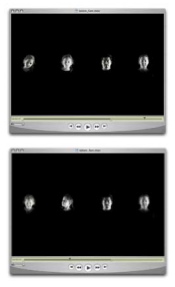Juan Morales, MFA ’07
project
The nature of these sound layers is meant to be suggestive of a personal trait or emotional quality that defines the character. Giving the sound an intimate quality is critical to how the audience responds to these caras. The intent is to draw interest below the surface level. The goal in combining these two elements is to suggest a connection between the tonality of the sounds playing and the emotions implied by the character’s gesturing. The interesting question here is which element–the visuals or the sounds–plays a greater role in creating a perspective or point of view of the cara the audience is then faced with. Perhaps the greater question is whether or not this combined media makes for a more impactful experience. In this case the intent is for the audience to get a deeper sense for each character’s persona and how that might impact their collective life as a family.
For now the totems are made up of black and white photographs of the faces set on black. While this does provide a clean and uncluttered setting for the audience to focus on the change in facial expressions color and real-life background settings might work as well. The goal is for the audience to gain insightful character impressions that will enhance the unfolding of narrative. Any implications made are articulated by character gestures and their accompanying sounds as the user interacts with the totems. The esthetic should remain clean so as not to detract from any gesturing or interaction between characters.
The combination of media is intended to make the process an engaging personal experience that draws on expression and doesn’t become just another multimedia slideshow. In a slideshow there is a linear progression from one item to the next. In this totemic system the user chooses which “cara” sequence is initiated causing a range of possibilities in how an embedded message or even story unfolds. In an interactive totem the sequence of caras selected by the user can for example, determine the proceeding series of sounds and character gestures. As the designer, the ensuing formula of user choices could be used to path the user through the experience to arrive at predetermined variable outcomes. These variable outcomes can be scripted to deliver different emotional experiences and messages. In the prototype I developed to explore these caras, high level of interactions were not explored. A single linear stream of each cara’s sounds and gestures was prompted by the user’s selection of each character and could with the opportunity to repeat the sequence as desired.
The totemic system allows for a character’s gesturing to be programmed in response to a point in another cara sequence. As it plays a particular visual and aural gesture along with that of another cara, the interaction can then suggest emotion and relationships between the characters. The fact that these types of expressions imply emotion allows them to change from literal to poetic devices throughout the course of the experience. This platform lends itself to conveying a point of view rather than simply presenting information.
Reflection
What originally drew me to the idea of combining mixed media elements in these totem sequences was the desire to put people together in an intimate context that provides emotional insights on the group and their relationships. In a practical sense, what better way is there to communicate that someone likes to sing than to actually hear them singing? Going a step further, hearing them miss a high note completely or improvise when they forget the words lends a genuine and intimate substance to the information being conveyed. That kind of information is more poignant and direct than being told that the person likes to sing and then being asked to believe that it’s true. It also has a quality of bringing the audience more into the moment by inviting them to identify with the characters on a more personal level. What is exciting about the totems is the potential it has to tell more complex stories. A more scripted approach could take better advantage of user interaction and make it an even more vital component to how the content is delivered. A deeper and more dynamic set of content could also be delivered that triggers different sets of gestures and sound by the order in which each cara is interacted with. That means that instead of one set of imagery and sound content being accessible per cara, the system can be expanded so that multiple interactions take place.
For instance, if the totem contains four people and the one farthest to the right is somewhat visually removed from the other three, that statement of isolation or separation can be augmented by other person(s) waking up and responding to that cara’s gestures and soundbytes with a display of one or more telling gestures of their own. To tell a larger story, mulitple totems can be combined to provide a cross-section of backgrounds and stories.
Imagine for example, if the power and content that could be conveyed in a totem of social workers and prison inmates whose identities are revealed only over time? The possibilities for discovery become broader as you consider the different ways the system can be manipulated and expanded to accommodate more complex non-linear narratives.
At the same time the system can be kept simple and poignant. Perhaps providing a discourse between only two caras that ends up providing a back and forth-style timeline of gestures and sound bytes rewards the user/audience for their interaction with a continually unfolding narrative. The key is to keep the framework scalable and easy to navigate. That allows the author to craft their content and messages to match the levels of storytelling and interactivity required to engage the audience to move toward the final resolution in the narrative.


